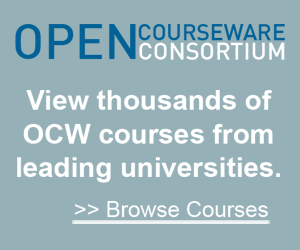As taught in: Spring 2011 
MIT undergraduate researcher Carrie Keach ('10) takes a core in Thoreau's Bog, Concord, MA. Peat cores contain historical records of metal deposition from the atmosphere over the past 100-200 years. (Image courtesy of Sarah Jane White. Used with permission.)

MIT undergraduate researcher Carrie Keach ('10) takes a core in Thoreau's Bog, Concord, MA. Peat cores contain historical records of metal deposition from the atmosphere over the past 100-200 years. (Image courtesy of Sarah Jane White. Used with permission.)
Instructors:
Prof. Samuel Bowring
Prof. Edward Boyle
Dr. Nilanjan Chatterjee
Dr. Francis Dudas
Prof. Edward Boyle
Dr. Nilanjan Chatterjee
Dr. Francis Dudas
MIT Course Number:
12.119
Level:
Undergraduate
Course Features
Course Description
This is a laboratory course supplemented by lectures that focus on selected analytical facilities that are commonly used to determine the mineralogy, elemental abundance and isotopic ratios of Sr and Pb in rocks, soils, sediments and water.
Labs: 2 sessions / week, 2.5 hours / session
Syllabus
Course Meeting Times
Lectures: 2 sessions / week, 1 hour / sessionLabs: 2 sessions / week, 2.5 hours / session
Prerequisite
Students need permission from instructors to enroll.Overview
This course focuses on analytical facilities that are used to determine elemental and isotopic abundances in soils, rocks, minerals, and fluids. Emphasis is on isotopic ratios of Sr, Nd, and Pb, which can be used for geochronology, and abundances of trace elements such as Rb, Sr, Cu, Cd, Hg, rare-earths, Pb, Th, and U. Analytical techniques include mass spectrometry, emission spectrometry, atomic absorption, neutron activation, and electron microprobe. A major lab project utilizes these techniques to address specific environmental and geologic problems.Reference Books
 Gill, Robin, ed. Modern Analytical Geochemistry (Longman Geochemistry Series). Addison Wesley Longman, 1997. ISBN: 9780582099449.
Gill, Robin, ed. Modern Analytical Geochemistry (Longman Geochemistry Series). Addison Wesley Longman, 1997. ISBN: 9780582099449. Potts, P. J. A Handbook of Silicate Rock Analysis. Chapman and Hall, 1987. ISBN: 9780412008818.
Potts, P. J. A Handbook of Silicate Rock Analysis. Chapman and Hall, 1987. ISBN: 9780412008818.
Calendar
| LEC # | TOPICS |
|---|---|
| 1 | Basic geochemistry & glaciology background |
| 2 | Specimen characterization with the Electron Microprobe Part 1 |
| 3 | Specimen characterization with the Electron Microprobe Part 2 |
| 4 | Toxic pollutants |
| 5 | Sr Isotope dating |
| 6 | U/Th/Pb dating |
| 7 | Anthropogenic Geochemistry |
| 8 | Inductively Coupled Plasma: Emission and Mass Spectrometry |
| 9 | Interferences in Inductively Coupled Plasma Mass Spectrometry |
Grading
30% on homework assignments and 70% on final report.Readings
| TOPICS | READINGS |
|---|---|
| Thoreau's bog | Whitney, Gordon G., and William C. Davis. "From Primitive Woods to Cultivated Woodlots: Thoreau and the Forest History of Concord, Massachusetts." Journal of Forest History 30, no. 2 (1986): 70-81. Hemond, Harold F. "Biogeochemistry of Thoreau's Bog, Concord, Massachusetts." Ecological Monographs 50, no. 4 (1980): 507-26. Schofield, Edmund A. "The Walden Ecosystem: 'A Perennial Spring in the Midst of Pine and Oak Woods'." Hemond, Harold F. Biogeochemistry of a New England Sphagnum Bog. Massachusetts Institute of Technology, Dept. of Civil Engineering, 1977. Corey, Cherrie. "Gowing's Swamp and Thoreau's Bog." Sudbury Valley Trustees. |
| Isotopes | West, Jason B., Janet M. Hurley, et al. "The Stable Isotope Ratios of Marijuana. II. Strontium Isotopes Relate to Geographic Origin." Journal of Forensic Sciences 54, no. 6 (2009): 1261-9. Norton, S. A., G. C. Evans, et al. "Comparison of Hg and Pb Fluxes to Hummocks and Hollows of Ombrotrophic Big Heath Bog and to Nearby Sargent Mt. Pond, Maine, USA." Water, Air, and Soil Pollution 100 (1997): 271-86. Shotyk, W., A. K. Cheburkin, et al. "Lead in Three Peat Bog Profiles, Jura Mountains, Switzerland: Enrichment Factors, Isotopic Composition, and Chronology of Atmospheric Deposition." Water, Air, and Soil Pollution 100 (1997): 297-310. Weiss, D., W. Shotyk, et al. "Atmospheric Lead Deposition from 12,400 to ca. 2,000 yrs BP in a Peat Bog Profile, Jura Mountains, Switzerland." Water, Air, and Soil Pollution 100 (1997): 311-24. |
Lecture Notes
| LEC # | TOPICS |
|---|---|
| 1 | Basic geochemistry & glaciology background |
| 2 | Specimen characterization with the Electron Microprobe Part 1 (PDF - 5.1MB) |
| 3 | Specimen characterization with the Electron Microprobe Part 2 (PDF - 4.2MB) |
| 4 | Toxic pollutants |
| 5 | Sr Isotope dating |
| 6 | U/Th/Pb dating |
| 7 | Anthropogenic Geochemistry (PDF - 2.2MB) |
| 8 | Inductively Coupled Plasma: Emission and Mass Spectrometry (PDF) |
| 9 | Interferences in Inductively Coupled Plasma Mass Spectrometry (PDF) |
Labs
| TOPICS | FILES |
|---|---|
| Protocol for Sample Treatment | (PDF) |
| Protocol Outline | (XLS) |
| Peat Sheets | (XLS) |
| Column Procedure Checklist | (XLS) |
| Ion Exchange Chromatography | (PDF) |
Assignments
Download Course Materials
This package contains the same content as the online version of the course.
For help downloading and using course materials, read our frequently asked questions.
Bowring, Samuel, Edward Boyle, Nilanjan Chatterjee, and Francis Dudas. 12.119 Analytical Techniques for Studying Environmental and Geologic Samples, Spring 2011. (Massachusetts Institute of Technology: MIT OpenCourseWare), http://ocw.mit.edu/ (Accessed 06 Dec, 2011). License: Creative Commons BY-NC-SA
For more information about using these materials and the Creative Commons license, see our Terms of Use.

No comments:
Post a Comment